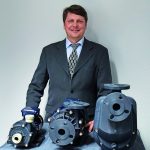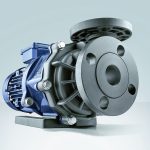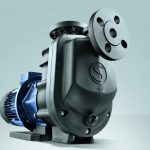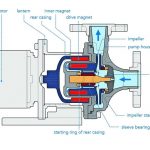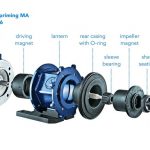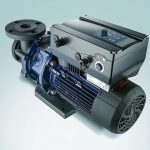For more than 50 years, Sondermann has specialized in magnetically coupled centrifugal pumps without shaft seal, being a market success all over the world. Now, the German company based in Cologne is opening up new paths. Together with a Japanese company, Sondermann has developed the innovative Magson pumps they will first present at Hannover Messe 2017. In the run-up to the event, Sondermann’s key account and product manager Oliver Keller has talked to us about these new pumps.
In 1961, Sondermann put the very first magnetically coupled centrifugal pump on the market. What kind of developments have been there in the course of the past 50 years?
Oliver Keller: When setting up his business, company founder Frank Sondermann imported a pump from the US, fitted a German motor to it and put it on the market. Since 1981, we have offered RM pumps as RM-TS, RM-MF, RM-MS and other types being developed by our German partner in the course of time. In cooperation with a Japanese partner, we have recently developed the new Magson pumps based upon our longstanding experience and technical knowhow of magnetically coupled centrifugal pumps. Assembled in our Cologne plant, Magson pumps are already available and will be presented to the public at Hannover Messe.
Which types and designs of the magnetically coupled centrifugal Magson pumps will be on offer?
Keller: In addition to non-self-priming Magson (MA) pumps, there are also self-priming MAS pumps available. The latter are especially used when the pump has to be placed above fluid level for safety reasons to deliver toxic or environmentally hazardous fluids out of double-shell tanks, for example. As Magson MAS pumps can run dry for a limited period of time, they are also suitable to drain a tank down to the last drop. At the moment, our MA pumps are available as types 2 to 6 with maximum discharge heads of 7 to 30 mWG and maximum volume flow rates of 70 to 510 l/min. Pump type 7 is being developed and we intend to put a smaller type on the market in the near future.
What’s the difference between these new Magson pumps and magnetically coupled pumps of the RM type?
Keller: The name of Magson stands for a new generation of magnetically coupled centrifugal pumps without shaft seal. Thanks to their modular design, these pumps allow you to considerably reduce both costs and downtime. If necessary, you can easily replace most of their components. Besides, they are less vulnerable to damage and thus achieve a much longer service life. As the modular design also cuts back on production and installation, we are able to sell the pumps at extremely competitive prices and with short delivery times. So, our standard pumps are usually delivered ex works within one week. Since Magson MA and self-priming MAS pumps are of identical design except for the housing, you can convert any MA pump of type 4 and higher into a self-priming centrifugal pump, using a pump housing with integrated priming tank.
Which other design details are characteristic of the modular principle used for Magson pumps?
Keller: All pumps of types 4 to 6 have the same shaft and sleeve bearing, one rear casing for each type and one driving magnet for all types with the same motor. Thanks to the so-called back pull-out design of pump type 4 and higher, the entire driving unit can be replaced without dismantling the pump. Thus, the system remains hermetically sealed throughout maintenance or repair work, reducing downtime to a minimum. Our pumps of type 4 to 6 also have the same shaft mounting in the pump housing. Its sleeve bearing has an additional plastic sheath to protect the bearing seat inside the inner magnet and the pump housing from overheating. So even in case of incomplete lubrication, most pump housings and impeller magnets remain undamaged. The extremely solid spiral housing is made of one streamlined piece to achieve utmost efficiency. The optimum suction fluid guidance around the centering shaft further enhances energy efficiency and saves energy costs. All these are features of pump type 4 and higher.
What’s the driving principle of the pumps?
Keller: The IEC standard motors (IE3) we use at the moment can be operated with frequency converters and PTC resistors. Upon request, IE4 motors are also available. A frequency converter can be retrofitted at any time and allows you to adjust the optimum operating point to changing conditions in order to considerably increase the efficiency of your pump. Magson pumps of type 4 and higher can be connected with either a threaded adapter or slip-on flange. So the pumps can be adapted to any connection without incurring further installation costs.
Which materials do you use for the components which get in contact with the fluid?
Keller: The housing, rear casing and impeller magnet are made either of polypropylene (PP) or especially resistant ethylene tetrafluoride ethylene copolymer (ETFE). If these components are made of ETFE instead of polyvinylidene difluoride (PVDF), you may use the pump to deliver both acids such as sulphuric acid and bases like caustic soda. Thanks to this universally applicable material, one pump is often enough for several purposes. Besides, the sheath of the inner magnet is injection-moulded without fibre reinforcement to further enhance its resistance and impermeability to diffusion. So even a less expensive pump made of PP is suitable to deliver highly concentrated acids.
Which markets and applications are these pumps especially meant for?
Keller: Magson pumps are perfect for all situations where absolute tightness and leakproof reliability are of utmost importance. So they are best suited to deliver highly aggressive acids and bases, degreasing baths, chemicals, highly corrosive liquids and all fluids tending to crystallize. Our pumps are not only used in plant and mechanical engineering but also in chemical and petrochemical industries.
What kind of tools do you offer for condition monitoring?
Keller: The RPR-Control 100 system electronically monitors the motor current to reliably protect the pump against dry running, overheating and overloading. In each of these cases, the RPR-Control 100 immediately switches off the pump to avoid any damage. Once the cause of failure has been eliminated, the pump is ready for use at once. RPR-Control 100 also allows you to monitor a set minimum flow rate. Thus, the electronic controller will detect a clogged filter and automatically demand the filter to be changed, for example.
What do you think is the specific power of Sondermann?
Keller: The optimum configuration of a pump system depends on various factors including the volume flow rate desired and the required delivery head. So, we precisely analyse our clients’ specific requirements on site and make up the optimum pump system out of the various types, designs, capacities, materials and accessories available, including products made by our Flux parent company or by other suppliers.
Hall 6, Booth B40
www.cpp-net.com search: cpp0217sondermann
Günter Eckhardt
Editor-in-chief,cpp chemical plants & processes
Share:



